

An encyclopedia of Middle-earth and Numenor

|
|
|
|
|
|
|
|
|
|
|
|
|
|
| |
|
 |

An encyclopedia of Middle-earth and Numenor |
 |

Names &
Etymology:
The name Bindbole Wood has
been mistakenly interpreted as Bindbale Wood because of unclear
type on some maps of the Shire. The word bole means "tree trunk."
Sources:
The Fellowship
of the Ring: Map of "A Part of the Shire"
The Lord
of the Rings: A Reader's Companion by Wayne G. Hammond and Christina
Scull: "The Maps of The Lord of the Rings," p. lvii
Atlas of
Middle-earth by Karen Wynn Fonstad, map of the Shire, p. 70-71
Chetwood |
The
Chetwood in the
New Line Cinema
film
|
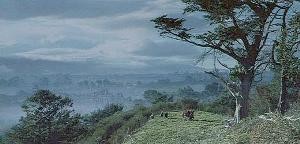 Woods
in Eriador outside Bree.
The Great East Road ran through
the southern edge of the Chetwood, while the Greenway
ran along the western edge. On the east side of the Chetwood lay the Midgewater
Marshes. The village of Archet was
located just inside the southwestern edge of the Chetwood.
Woods
in Eriador outside Bree.
The Great East Road ran through
the southern edge of the Chetwood, while the Greenway
ran along the western edge. On the east side of the Chetwood lay the Midgewater
Marshes. The village of Archet was
located just inside the southwestern edge of the Chetwood.
Aragorn led the Hobbits into the Chetwood after they left Bree to avoid pursuit. They entered the woods on September 30, 3018 of the Third Age, and emerged on October 2. During the War of the Ring, robbers hid in the Chetwood beyond Archet and preyed upon Bree-landers and travellers. The robbers were driven out when the King's messengers returned to the North.
Names &
Etymology:
The word Chetwood is a a
compound of Celtic and English, both words meaning "wood."
Sources:
The Fellowship
of the Ring: "At the Sign of the Prancing Pony," p. 161; "A Knife in
the Dark," p. 193-94
The Return
of the King: "Homeward Bound," p. 271
Atlas of
Middle-earth by Karen Wynn Fonstad, map of Eriador p. 74-75; map of
Bree p. 125
"Nomenclature
of The Lord of the Rings," entry for Archet
Aragorn led the Grey Company through the Dimholt to the Dark Door on March 8, 3019 of the Third Age. The Dimholt was so gloomy that even Legolas of Mirkwood was disturbed.
Names &
Etymology:
The word dim means "dark"
but also "obscure, secret";
holt is a poetic word for "wood, grove."
Drúadan Forest |
Map
of the Druadan Forest
|
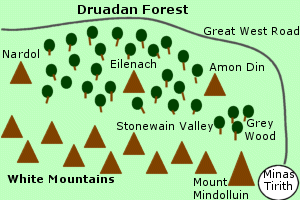 Forest
in Gondor. The Druadan Forest was located in
Anorien
at the northeastern end of the White Mountains near Minas
Tirith. The Great West Road
ran along the northern edge of the forest before curving south to Minas
Tirith. The
Stonewain Valley cut through
the southern edge of the forest at the foot of the
White
Mountains. At the far eastern end of the forest was a thicket of trees
known as the Grey Wood.
Forest
in Gondor. The Druadan Forest was located in
Anorien
at the northeastern end of the White Mountains near Minas
Tirith. The Great West Road
ran along the northern edge of the forest before curving south to Minas
Tirith. The
Stonewain Valley cut through
the southern edge of the forest at the foot of the
White
Mountains. At the far eastern end of the forest was a thicket of trees
known as the Grey Wood.
Three of the Beacon-hills of Gondor were located in the Druadan Forest. The first was Amon Din, a rocky, barren hill on the eastern edge of the forest closest to Minas Tirith. Eilenach was in the middle, surrounded by pine trees. It was the highest point in the forest, but its sharp summit could only accommodate a small beacon. The third Beacon-hill was Nardol, on a ridge at the western edge of the forest. The trees around Nardol had been cut down and quarries had been dug nearby. There was a road leading from the quarries through Stonewain Valley to Minas Tirith.
The Druadan Forest may have been one of the first places in northwestern Middle-earth to be settled by Men. Historians of Gondor believed that the first Men to come west across the Anduin were the Druedain, who settled in the vales of the White Mountains and the forests on the northern side of the mountains. By the end of the Third Age, the Druadan Forest was one of the few places where the descendants of the Druedain still dwelled.
On March 13, 3019 of the Third Age, the Riders of Rohan led by King Theoden and his nephew Eomer came to the Druadan Forest on their way to Minas Tirith. With them was the Hobbit Merry Brandybuck. Theoden and Eomer met with Ghan-buri-Ghan, headman of the Druedain who lived in the forest. Ghan-buri-Ghan told the Rohirrim that the Great West Road was guarded by the forces of Sauron, but that he could lead them by the forgotten road through Stonewain Valley. Theoden agreed, and each company of Riders was guided by one of the Druedain, with Ghan-buri-Ghan leading the King.
In the late afternoon of March 14, they arrived at the eastern end of the Druadan Forest where the trees of the Grey Wood shielded them from sight. Scouts found the bodies of the messengers who had summoned them to the aid of Gondor, and the Rohirrim feared that news of their coming had not reached Denethor, the Steward of Gondor. At dawn on March 15, the Rohirrim charged onto the Pelennor Fields and engaged the enemy forces in battle.
After the War of the Ring, on July 22, 3019, Aragorn, King Elessar, came to the edge of the Grey Wood. There he decreed that the Druadan Forest belonged to Ghan-buri-Ghan and his people in perpetuity and that no man could enter the forest without their leave.
Names &
Etymology:
Also called the Forest of Druadan.
Drúadan
Forest was named after the Drúedain who lived there. The element
Drû
in Sindarin was derived from Drughu, the Drúedain's own name
for themselves. The word adan means Man; the plural is
edain.
In Common Speech,
Drúadan was loosely translated as "Wild
Man."
The Sindarin name was Tawar-in-Drúedain. The word tawar means "wood, forest."
The Grey Wood was the name of the thicket of trees east of Amon Din at the edge of the Druadan Forest.
Sources:
The Return
of the King: "The Ride of the Rohirrim," passim; "Many Partings," p.
254
Unfinished
Tales: "Cirion and Eorl," p. 319 (note 51); "The Druedain," p. 382-84,
385 (note 6)
The History
of Middle-earth, vol. V, The Lost Road and Other Writings: "The Etymologies,"
entry for TAWAR
The Journeys
of Frodo by Barbara Strachey: Map #43, "Druadan Forest"
Eryn Vorn was a remnant of the great forests that once covered Minhiriath and Enedwaith. Most of the trees had been cut down during the first part of the Second Age by the Men of Numenor, who used the timber to build ships. The inhabitants the forests of Minhiriath tried unsuccessfully to stop the Numenoreans from destroying their home. The survivors fled to the forest on the Cape of Eryn Vorn. They were mainly hunter-folk who had little contact with outsiders.
Names &
Etymology:
The name Eryn Vorn means
"Dark Wood" from the word eryn meaning "wood" and vorn from
morn
meaning "dark."
Sources:
Unfinished
Tales: "The History of Galadriel and Celeborn - Appendix D: The Port
of Lond Daer," p. 262; Index, p. 436
Fangorn Forest |
Fangorn
Forest by Alan Lee
Artwork for the New Line film |
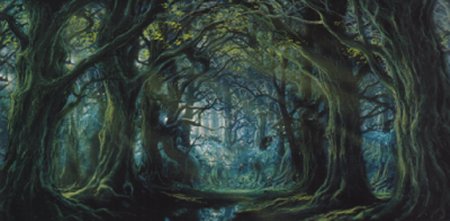 Home
of the Ents. Fangorn Forest was located at the southeastern end of the
Misty
Mountains near the Gap of Rohan.
The mountains formed the western border of Fangorn. At the end of the mountain
range stood the stronghold of Isengard near
the southwestern corner of the forest.
Home
of the Ents. Fangorn Forest was located at the southeastern end of the
Misty
Mountains near the Gap of Rohan.
The mountains formed the western border of Fangorn. At the end of the mountain
range stood the stronghold of Isengard near
the southwestern corner of the forest.
To the east and south of Fangorn was the land of Rohan. Lothlorien lay about 75 miles north of Fangorn. Fangorn Forest stretched approximately 100 miles from north to south and 100 miles from east to west, covering an area of about 10,000 square miles.
Two rivers flowed from Fangorn Forest. In the northern part of the forest, the Limlight flowed from the woods and then formed the northern border of Rohan before emptying into the Anduin.
In southern Fangorn, the Entwash sprang from the slopes of Methedras, the last peak of the Misty Mountains. The river emerged from Fangorn and flowed southeastward through Rohan to the Anduin. The waters of the Entwash had special properties and promoted growth and vigor in living things.
In southwestern Fangorn was the bowl-shaped valley of Derndingle, where the Ents held meetings called Entmoots. Below the springs of the Entwash was Wellinghall, the main home of Treebeard, the eldest of the Ents. Farther down the Entwash, about 3 to 4 miles from the eastern edge of the forest, there was a bare hill with stone steps leading to the top where Treebeard stood and looked out over the land.
Fangorn Forest was dense and tangled, and the air felt heavy and musty. It was dim under the trees, though not completely dark like Mirkwood. To the outside world Fangorn Forest had a reputation as a strange and dangerous place. But though there were dark patches, Fangorn Forest was not an evil place and it was dangerous only to those who threatened its trees.
The forest was home to many different kinds of trees, including ash, beech, birch, chestnut, fir, linden, oak, rowan, and willow, as well as some trees that were unlike any others in Middle-earth. Many of the trees were very old and some were hung with strands of lichen like trailing beards. Some of the trees were more awake and aware than others.
In addition to the ordinary trees, there were also Huorns - trees or treelike beings that could walk and speak. Some were scattered among the trees while hundreds of others lived in dales deep in the forest. Huorns may have been trees that had become Entish or Ents that had become treeish.
The Ents were great sentient beings that guarded the forest and shepherded the trees. They roamed the woods, keeping out strangers and caring for the trees - watching, training, teaching, and weeding. Ents resembled trees, but they were counted among the free peoples of Middle-earth. Their race was more ancient than any in Middle-earth except the Elves.
Three of the original Ents dwelled in Fangorn Forest: Treebeard, Skinbark, and Leaflock. Other Ents of Fangorn included Beechbone and Quickbeam. There were no Entwives in Fangorn, for they had left the woods long ago to tend gardens and crops east of the Anduin. Without the Entwives, there were no Entings either.
Fangorn Forest was originally part of one great wood that covered the lands west of the Misty Mountains. Fangorn was then known as the East End - a section of the great wood that extended east of the mountains. During the Second Age, most of the woods were cut down by Men or destroyed during Sauron's invasion of Eriador. By the end of the Third Age the only remnants of the great wood were the Old Forest in the north and Fangorn in the south.
At one time, Fangorn Forest was connected to the woods of Lothlorien by an area of open woodland with small trees. There was no visible border between the two forests, but Treebeard and the King of the Galadhrim of Lothlorien (possibly Amdir, father of Amroth) agreed that the forests of the Ents and the Elves would be separate. In time the woodland between the two forests receded and Lothlorien and Fangorn were divided from one another completely.
At the end of the Second Age, Treebeard and some of the Ents went in search of the Entwives, but their gardens had been destroyed by Sauron's forces and the Entwives were gone to an unknown fate. The Ents returned to Fangorn and became isolated and forgotten by the outside world except as legends. Few people ever dared to venture into Fangorn Forest.
In 2759 of the Third Age, Saruman came to live in Isengard near the southwestern edge of Fangorn. Saruman sometimes walked in the forest and he became acquainted with Treebeard, who told him many things about the woods though the Wizard did not share information in kind.
Saruman sought to become a Power in Middle-earth, and he created an army and machinery at Isengard. His Orcs began to cut down trees in Fangorn Forest, mainly to be used as fuel for forges and furnances. On the wooded slopes west of Isengard, the destruction was particularly bad. Some Ents were slain and Skinbark was gravely wounded. He retreated farther up into the mountains and refused to come down. At first Treebeard did not realize that Saruman was responsible for the destruction of the trees in Fangorn Forest, but in time he began to consider what he should do to stop the Wizard.
On February 29, 3019, Merry Brandybuck and Pippin Took escaped from Saruman's Uruk-hai and entered Fangorn Forest. They met Treebeard on the look-out hill near the edge of the forest, and the Ent brought the Hobbits to Wellinghall. After hearing their story, Treebeard decided that it was time to take action against Saruman. He summoned the other Ents to an Entmoot in Derndingle on February 30.
That same day, Aragorn, Legolas, and Gimli tracked the Hobbits to the edge of Fangorn Forest. They camped under the trees and during the night they saw an old man who was actually Saruman trying to learn what had become of the Hobbits, for he mistakenly believed they had the One Ring. The next day, the Three Hunters met another old man who turned out to be Gandalf the White. Gandalf assured them that the Hobbits were in safe hands, and they left Fangorn for Edoras.
On March 2, the Ents decided to go to war against Saruman. About 50 Ents marched forth from Fangorn Forest accompanied by many hundreds of Huorns as well as Merry and Pippin. The Ents destroyed Isengard and imprisoned Saruman in the Tower of Orthanc, while a number of Huorns assisted in the victory over Saruman's army at the Battle of Helm's Deep.
After the War of the Ring, Legolas returned to Fangorn Forest to explore accompanied by Gimli. Aragorn - now King Elessar - gave the Ents permission to expand into the Wizard's Vale and west of the Gap of Rohan, but Treebeard doubted that the Ents would leave Fangorn Forest again now that the age of Men had begun. Fangorn Forest was left to grow in peace, and in time the Ents became the stuff of legend once more.
Names &
Etymology:
Fangorn Forest was named
for Treebeard, the eldest of the Ents, whose name translates as Fangorn
in Sindarin from fanga meaning "beard" and orne meaning "tree."
Fangorn Forest was called the Entwood by the Rohirrim.
When Fangorn Forest was part of the great woods of ancient times, it was known as the East End.
Treebeard referred to the forest by several Quenya names. Ambaróna means "uprising, sunrise, Orient" from amba meaning "upwards" and róna meaning "east." Fangorn was originally the East End of a greater forest. Aldalómë means "tree twilight" from alda meaning "tree" and lómë meaning "dusk, twilight." Tauremorna means "gloomy forest" from taur meaning "forest" and morna meaning "gloomy, somber." Tauremornalómë means "gloomy twilight forest."
Sources:
The Two
Towers: "The Riders of Rohan,", p. 43-46; "The Uruk-hai," p. 61-63;
"Treebeard," passim; "The White Rider," passim; "The Road to Isengard,"
p. 152-55; "Flotsam and Jetsam," p. 169-77
The Return
of the King: "Many Partings," p. 257-60
Unfinished
Tales: "The History of Galadriel and Celeborn - Appendix C, The Boundaries
of Lorien," p. 261
The Silmarillion:
"Appendix - Elements in Quenya and Sindarin Names," entries for alda,
lome, taur
The History
of Middle-earth, vol V, The Lost Road and Other Writings: "The Etymologies,"
entries for AM2, MBAR, MOR, ORO & SPANAG
The Lord
of the Rings: A Reader's Companion by Wayne G. Hammond and Christina
Scull: "Treebeard," p. 384-85
The trees of the Firien Wood descended into a deep cleft called the Firien-dale. Types of trees in the Firien Wood included oaks and birches. The trees were dense, especially along the Mering Stream. There was a powerful silence under the trees that caused people to speak in hushed voices, and the forest was known as the Whispering Wood.
At the southeastern corner of the woods stood Halifirien, the Hill of Awe. Halifirien was the sacred burial site of King Elendil. A path marked by standing stones led through the Firien Wood to the foot of the hill, where a stone stairway ascended to the summit.
In 2510 of the Third Age, Cirion, the Steward of Gondor, brought Eorl through the Firien Wood to Halifirien. There Cirion gave Eorl the land that became Rohan, and Eorl took an oath to come to the aid of Gondor in times of need.
Afterwards, Cirion had the tomb of Elendil moved to the Hallows of Minas Tirith and Halifirien became the last of the seven Beacon-hills of Gondor. Over time, the Rohirrim took charge of maintaining the beacon and although part of the Firien Wood was in Gondor the entire wood came to be considered the domain of the Kings of Rohan.
No trees were cut down in the Firien Wood except as needed to keep the roads clear. No one lived in the woods, though the wardens tending the beacon had lodgings on Halifirien. There were a number of birds and wild beasts in the woods. In 2864, King Folca of Rohan came to the Firien Wood to hunt the great Boar of Everholt. He slew the boar but later died of tusk-wounds.
After the War of the Ring, King Eomer of Rohan came to the Firien Wood with Aragorn, King Elessar. Atop Halifirien, King Eomer renewed the Oath of Eorl, and King Elessar renewed the Gift of Cirion.
Names &
Etymology:
Also written as Firienwood.
The full name was Halifirien Wood. The name Firien Wood comes
from the Anglo-Saxon firgen-wudu, meaning "mountain wood." The full
name Halifirien Wood means "holy mountain wood"; the element hal
comes from hálig meaning "holy." It was also called
the Firienholt - where the word holt means "wood."
Also called the Whispering Wood and the Wood of Anwar. Amon Anwar was the Sindarin name for Halifirien; the word anwar means "awe."
The older Sindarin name was Eryn Fuir, meaning "North Wood." The word eryn means "wood" and fuir is derived from forn meaning "north."
Sources:
The Return
of the King: "The Muster of Rohan," p. 77-78
Appendix
A of The Lord of the Rings: "The House of Eorl," p. 350
Unfinished
Tales: "Cirion and Eorl," p. 300-310, 314 note 33, 317 note 44
"The Rivers
and Beacon-hills of Gondor," by J.R.R. Tolkien, edited by Carl F. Hostetter,
commentary by Christopher Tolkien, in Vinyar Tengwar #42, July 2001,
p. 20
Forest of Brethil |
Map
of the Forest of Brethil
|
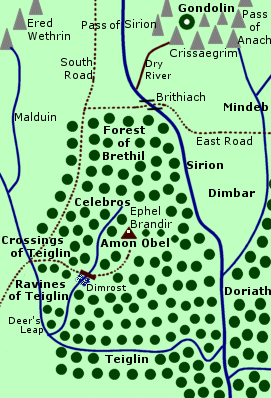 Woods
in Beleriand where the Men of the House of Haleth lived. The Forest of
Brethil was located west of the great woodland realm of Doriath.
It was not within the Girdle of Melian which protected Doriath. Brethil
was a dense, dark forest.
Woods
in Beleriand where the Men of the House of Haleth lived. The Forest of
Brethil was located west of the great woodland realm of Doriath.
It was not within the Girdle of Melian which protected Doriath. Brethil
was a dense, dark forest.
The forest was situated on a highland above the Teiglin, which flowed through a series of deep ravines as it curved around the southern border of Brethil. The Crossings of Teiglin were located near the southwestern corner of the forest. There was a small stretch of woodland south of the Teiglin that was not part of the Forest of Brethil.
The Sirion flowed along the eastern border of the Forest of Brethil. The empty region of Dimbar lay east of the Sirion and beyond were the woods of Doriath.
Two major roads of Beleriand ran along the western and northern borders of Brethil. The Old South Road that came down from the Pass of Sirion passed through the far western edge of the forest and over the Crossings of Teiglin and then continued on to Nargothrond.
The East Road intersected with the South Road at the northwest corner of the forest. The road skirted the northern edge of Brethil to the Sirion, where it passed over the Fords of Brithiach into Dimbar.
In the midst of the Forest of Brethil stood a hill named Amon Obel. The walled settlement of Ephel Brandir was on the summit of Amon Obel. There was also an outdoor meeting place called the Moot-ring carved into the back side of the hill with seven tiers of seats enclosed by a stockade. There was a path through the forest to Amon Obel from the Crossings of Teiglin.
A stream called the Celebros flowed southwestward through Brethil to the Teiglin. The path to Amon Obel crossed the Celebros over a wooden bridge. Below the bridge was a waterfall named Dimrost, the Rainy Stair. There was a view from the bridge to the Ravines of Teiglin two miles away. The Celebros joined the Teiglin at Cabed-en-Aras, the Deer's Leap - the narrowest of the Ravines of Teiglin.
King Thingol of Doriath originally considered the Forest of Brethil to be a part of the realm of Doriath even though it was outside the Girdle of Melian. No one dwelled in Brethil because the woods were so dark and dense.
In 390 of the First Age, Haleth led her people from Estolad to the Forest of Brethil. Thingol did not want to allow Men to live there, but Finrod Felagund convinced him to agree on the condition that the People of Haleth would guard the Crossings of Teiglin and prevent Orcs from entering Brethil.
Haleth died in 420. She was buried in the heights of Brethil under a green mound called the Ladybarrow - also known as Haudh-en-Arwen in Sindarin and Tur Haretha in the language of her people.
The People of Haleth were freemen who lived on their own homesteads throughout the forest. They dealt with matters of justice by holding a Moot of the masters of the homesteads presided over by their Cheiftain. The Chieftain was also called the Halad, or Warden. The people had a say in choosing their leader, though it became customary to select the eldest heir of the line of Haleth.
Haleth herself had no children. Her nephew Haldan became the leader of the People of Haleth after her death. In 436, Haldan's grandchildren Haldir and Hareth married Gloredhel and Galdor of the House of Hador at a feast. Gloredhel moved to the Forest of Brethil to live with her husband Haldir. Hareth relocated to Galdor's home in Dor-lomin, and they had two sons, Hurin and Huor.
Haldan's son Halmir became Chieftain in 451. The Forest of Brethil was untouched by the Battle of Sudden Flame in 455-56 because Morgoth's forces were prevented from coming through the Pass of Sirion. After the battle in 456, a number of refugees of the House of Beor led by Emeldir came to Brethil from Dorthonion.
Sauron captured the Pass of Sirion in 457, and in 458 a legion of Orcs came down the Pass and approached the borders of Brethil. Halmir joined forces with Beleg Strongbow and the march-wardens of Doriath and together they defeated the Orcs. Afterwards, the Forest of Brethil was at peace for many years.
At the time of the battle, Hurin and Huor were being fostered by their uncle Haldir in Brethil. The brothers became lost during the skirmish and were taken to the Hidden Realm of Gondolin by Thorondor's Eagles. They were returned to their home in Dor-lomin after about a year.
In 465, Beren and Luthien came to the Forest of Brethil during their quest to steal a Silmaril from Morgoth. At the same time, Feanor's sons Celegorm and Curufin came through the forest on their way to Himring. They had earlier imprisoned Luthien in Nargothrond in an attempt to force her into marriage with Celegorm, and now they seized Luthien and attacked Beren. Beren fought them off with the help of Huan the Hound, but Curufin shot Beren with an arrow as he fled. Huan found athelas in the forest to help heal Beren's wound.
In 468, Halmir joined the Union of Maedhros against Morgoth, but he died in 471 before the war began. His son Haldir became Chieftain and he led an army from Brethil to the Battle of Unnumbered Tears on Anfauglith in 472. Haldir and all but three of his men were slain and Morgoth's forces were victorious. The three survivors were aided by Mablung of Doriath, and they returned to Brethil where the remainder of their people dwelled under the leadership of Haldir's son Handir. Haldir's wife Gloredhel died of grief.
Morgoth's forces roamed Beleriand and threatened the borders of Brethil though they did not enter the forest. Dimbar was overrun by Orcs around 485. A company of Orcs came across the Fords of Brithiach. Handir and his men resisted them, but the Orcs continued on to the Crossings of Teiglin to plunder the settlements of the Woodmen south of Brethil. A number of Woodmen - mainly women and children - fled to Brethil. Beleg temporarily drove the Orcs out of Dimbar, but the Orcs returned after Beleg left Doriath to join Turin on Amon Rudh.
Orcs attacked the Forest of Brethil in the spring of 495 in order to capture the Crossings of Teiglin as a precursor to the sack of Nargothrond. Handir was slain and the Men of Brethil were forced to retreat. Handir's son Brandir became Chieftain, though some doubted his ability to lead. Brandir had a gentle nature and could not fight because of a lame leg. He adopted a policy of secrecy in hopes of avoiding conflict with Morgoth's forces, and he withdrew his people into a stockade on Amon Obel called Ephel Brandir.
Some Men of Brethil led by Dorlas disobeyed Brandir and continued to fight Orcs on the borders of Brethil. After the fall of Nargothrond, a company of Orcs taking prisoners to Angband came to the Crossings of Teiglin. Dorlas and his men attacked them, but the Orcs slew all the captives including Finduilas, daughter of King Orodreth. The men buried Finduilas in a grave near the Crossings called Haudh-en-Elleth, the Mound of the Elf-maid.
The next year in 496, Turin came to Brethil in search of Finduilas. He came upon Dorlas and his company surrounded by Orcs and rescued them. Turin decided to remain in Brethil. Later that year, he found a woman lying on Haudh-en-Elleth. Turin called her Niniel, not realizing she was his sister Nienor. Turin and Nienor had never met, and Nienor had amnesia because of a spell cast by Glaurung.
As they crossed the bridge over Dimrost looking towards the Ravines of Teiglin, Niniel shivered uncontrollably, and afterwards the falls were called Nen Girith, the Shuddering Water. Brandir fell in love with Niniel, but she married Turin in 498. The Forest of Brethil had been at peace for a few years, but at the end of 498, Glaurung sent Orcs from Nargothrond to Brethil. The Men of Brethil defeated them with Turin's help.
In the spring of 499, Glaurung came to Brethil in search of Turin. Turin took charge of organizing the defense of Brethil, and Brandir's wishes were no longer heeded. Turin advised the Men of Brethil to remain in Ephel Brandir but to scatter if Glaurung approached, while he himself set out to slay the Dragon accompanied by Dorlas and Brandir's kinsman Hunthor.
Glaurung planned to cross the Teiglin at the narrow ravine called the Deer's Leap. Turin and Hunthor descended into the ravine, but Dorlas was too afraid. As the Dragon crossed overhead, Hunthor was killed by a falling rock. Turin was able to stab Glaurung's underbelly and mortally wound him.
Before he died, Glaurung told Niniel that she was Turin's sister and she committed suicide by throwing herself into the Deer's Leap, which then became known as Cabed Naeramarth, the Leap of Dreadful Doom. For a time afterwards, people and animals avoided the ravine and trees did not grow there.
Brandir slew Dorlas for his cowardice. He then told Turin about Niniel, but Turin accused Brandir of lying and killed him. When Turin realized the truth, he went to the ravine where Niniel had died and killed himself.
Glaurung's body was burned and nothing grew there. Turin was buried beneath a gravestone that was also carved with Niniel's name, though her body was not recovered. The marker was called the Stone of the Hapless or Talbor, the Standing Stone.
After Brandir's death, his kinsman Hardang was selected as Chieftain. Hardang was the most senior patrilineal descendant of Haleth. But many people had wanted to chose Hunthor's brother Manthor, who was a descendant of Haleth through a female line. Although females and their descendants were eligible to become Chieftain, this had not happened since the time of Haleth.
In 501, Hurin - the father of Turin and Nienor Niniel - came to Brethil and found his wife Morwen sitting by their children's gravestone. Morwen died at sunset, and Hurin became angry that the Men of Brethil had not helped her.
Hurin was found by Manthor's company and was brought before Hardang, who was not pleased to see him. Hurin threw a stool at Hardang and was thrown in prison. A Moot attended by nearly a thousand people was held to determine his fate.
Hurin accused Hardang of failing to help Morwen and there was an uproar among those assembled. In fact, Hardang had not even known that Morwen had come to Brethil, but in the face of violent opposition he retreated to the Hall of the Chieftains. That night, the Hall was set on fire and Hardang was slain. Manthor was later shot with an arrow by Avranc, son of Dorlas, who was loyal to Hardang.
No direct descendants of Haleth remained and the leadership of the People of Haleth fell to lesser men. According to one version, Avranc became Chieftain, though his selection was disputed. For the most part, people returned to their scattered homesteads and minded their own affairs.
Morwen was buried near her son and her name was added to the gravestone. After Beleriand sank beneath the Sea during the War of Wrath at the end of the First Age, the gravestone remained above water as an island called Tol Morwen.
Names &
Etymology:
The word brethil in the name
Forest
of Brethil is defined as "beech-tree" in Sindarin in The
Etymologies. (However it should be noted that the Appendix to
The
Silmarillion gives the definition of brethil as "silver
birch" as in the Birchwoods of Nimbrethil.) Also
called Brethiliand.
Sources:
The Silmarillion:
"Of Beleriand and Its Realms," p. 120; "Of the Coming of Men into the West,"
p. 147; "Of the Ruin of Beleriand," p. 155, 157-59; "Of Beren and Luthien,"
p. 176-77; "Of the Fifth Battle," p. 189-90, 192, 195; "Of Turin Turambar,"
p. 201-3, 205, 212, 216-17, 219-26; "Of the Ruin of Doriath," p. 229-30;
"Appendix - Elements in Quenya and Sindarin Names," entry for brethil
Unfinished
Tales: "Of Tuor and His Coming to Gondolin," p. 41, 54; "Narn I Hin
Hurin," p. 57, 63, 68, 73, 85, 87, 90-91, 104, 109-12, 121-46, 149 notes
24-26, 150 notes 27-29
The Children
of Hurin: "The Childhood of Turin," p. 33, 35, 37, 46-47; "The Battle
of Unnumbered Tears," p. 53, 56; "The Departure of Turin," p. 75; "Turin
among the Outlaws," p. 98, 102, 107-11; "Of Mim the Dwarf," p. 122, 136;
"The Land of Bow and Helm," p. 142-43; "The Fall of Nargothrond," p. 176;
"The Coming of Turin into Brethil," passim; "Nienor in Brethil," passim;
"The Coming of Glaurung," passim; "The Death of Glaurung," passim; "The
Death of Turin," passim; "Appendix," p. 289-92
The History
of Middle-earth, vol. III, The Lays of Beleriand: "The Lay of Leithian,"
p. 269 (athelas in Brethil)
The History
of Middle-earth, vol. V, The Lost Road and Other Writings: "The Etymologies,"
entries for BERETH and NEL
The History
of Middle-earth, vol. XI, The War of the Jewels: "The Grey Annals,"
p. 49, 51, 56-58, 67, 70, 72, 74, 79, 84-85, 89, 92-93, 95-103, 141, 144-45,
147-48, 151-65; "The Later Quenta Silmarillion," p. 182 (map), 223, 236,
237 (genealogy), 238, 241; "The Wanderings of Hurin," passim
Nan Elmoth |
Map
of Nan Elmoth
|
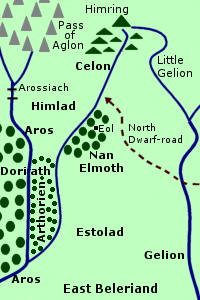 Dark
woods where Eol dwelled. Nan Elmoth was located
in East Beleriand. The woods were bordered on the northwest by the Celon.
Himlad was across the river to the west of Nan Elmoth, and the great forest
realm of Doriath lay to the southwest. The region
of Estolad was south of Nan Elmoth. The
northern Dwarf-road from the Blue Mountains
passed near Nan Elmoth.
Dark
woods where Eol dwelled. Nan Elmoth was located
in East Beleriand. The woods were bordered on the northwest by the Celon.
Himlad was across the river to the west of Nan Elmoth, and the great forest
realm of Doriath lay to the southwest. The region
of Estolad was south of Nan Elmoth. The
northern Dwarf-road from the Blue Mountains
passed near Nan Elmoth.
In ancient times, Nan Elmoth was a starlit, enchanted wood. Within the forest was a glade that was open to the sky. But over time, the trees in Nan Elmoth grew to become the tallest and darkest in Beleriand. Sunlight never penetrated the canopy and the woods were always in shadow.
After the Battle of the Powers from 1090 to 1099 of the Years of the Trees, the lands of Beleriand were ruined and desolate. Melian, a Maia from the Undying Lands, helped new forests grow there. She especially loved the woods of Nan Elmoth and she dwelled there with her nightingales.
In 1130, Thingol found Melian in a glade in Nan Elmoth. They fell in love and both fell into a deep trance that lasted until 1152. During this time the trees of Nan Elmoth grew taller and darker around them. After they awoke, Thingol and Melian left Nan Elmoth and founded the realm of Doriath.
After the First Battle in 1497, Melian created a protective barrier called the Girdle of Melian around Doriath. At this time, Eol the Dark Elf decided to leave Doriath and resettle in Nan Elmoth. Thingol required a fee for permission to dwell in Nan Elmoth even though the woods were outside the bounds of his realm, and Eol gave him the sword Anglachel. Eol's house was deep in the woods, about fifteen miles from the northernmost border of Nan Elmoth.
In 316 of the First Age, Aredhel of Gondolin strayed into Nan Elmoth from Himlad. Eol lured her to his house and he made her his wife. She gave birth to a son in 320 who was named Maeglin. Aredhel and Maeglin were forbidden to go abroad from Nan Elmoth in daylight, but they sometimes disobeyed and rode to the eaves of the forest to enjoy the sunlight.
In 400, while Eol was away visiting Nogrod, Maeglin convinced his mother to run away from Nan Elmoth and return to Gondolin, but Eol followed them. King Turgon of Gondolin forbade Eol to leave since he had found his hidden realm, but Eol decided to kill himself and Maeglin instead. He threw a javelin at Maeglin but Aredhel stepped in its path and she died. Eol was executed. Maeglin remained in Gondolin but later betrayed the city's location to Morgoth.
Nan Elmoth was lost when Beleriand was destroyed in the War of Wrath at the end of the First Age.
Names &
Etymology:
The name Nan Elmoth is composed
of the Sindarin words nan meaning "valley" and elmoth comprised
of el meaning "star" and moth meaning "dusk."
On one map (HoME XI, p. 183), Nan Elmoth is also labelled with the name Gladuial which means "twilight wood" in Sindarin from glad meaning "wood" and uial meaning "twilight."
Sources:
The Silmarillion:
"Of Thingol and Melian," p. 55-56; "Of Eldamar," p. 58; "Of Maeglin," p.
132-36; "Of the Coming of Men into the West," p. 142; "Of Turin Turambar,"
p. 201-2; "Appendix - Elements in Quenya and Sindarin Names," entries for
el,
moth, nan(d), and uial
The History
of Middle-earth, vol. X, Morgoth's Ring: "The Annals of Aman," p. 83-84
The History
of Middle-earth, vol. XI, The War of the Jewels: "The Grey Annals,"
p. 6-7, 9, 47-48; "The Later Quenta Silmarillion," p. 183 (map), 188; "Maeglin,"
passim
Hiswelókë's
Sindarin Dictionary
Nan-tathren |
Map
of Nan-tathren
|
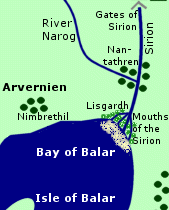 Land
of Willows in Beleriand. Nan-tathren was a wooded area at the confluence
of the Narog and the Sirion. The rivers
were slow and broad as they flowed through Nan-tathren. South of Nan-tathren,
the Sirion entered a marshy region and formed the Mouths of Sirion as it
emptied into the Bay of Balar.
Land
of Willows in Beleriand. Nan-tathren was a wooded area at the confluence
of the Narog and the Sirion. The rivers
were slow and broad as they flowed through Nan-tathren. South of Nan-tathren,
the Sirion entered a marshy region and formed the Mouths of Sirion as it
emptied into the Bay of Balar.
Willow trees grew in abundance on the riverbanks in Nan-tathren and there were meadows of lush green grass filled with flowers. It was a beautiful and enchanting place. Few people lived in the area around Nan-tathren. Treebeard sometimes wandered there, especially in the springtime.
After the Battle of Unnumbered Tears in 472 of the First Age, Morgoth's forces roamed freely into Beleriand and some even came as far south as Nan-tathren. In 473, King Turgon of Gondolin sent messengers in search of the Undying Lands to request the Valar's help against Morgoth. One messenger named Voronwe stopped in Nan-tathren and was so enchanted by its beauty that he briefly forgot his mission.
At last - possibly prompted by Ulmo, Lord of Waters, whose power was strong in Nan-tathren - Voronwe built a raft of willow boughs and continued on his way to the Isle of Balar. Although Voronwe did not succeed at his mission, he played an important role by leading Tuor to Gondolin.
After the fall of Gondolin in 510, Tuor escaped with a group of survivors including his wife Idril and son Earendil. They stopped to rest in Nan-tathren and held a feast in memory of those who had died. The survivors then settled at the Mouths of Sirion, and Earendil later convinced the Valar to defeat Morgoth in the War of Wrath.
Beleriand was destroyed during the war and most of the land including Nan-tathren was covered by the Sea. Several millennia later at the end of the Third Age, Galadriel told Treebeard that they would not meet again in Middle-earth, but that when the world changed and the lands beneath the Sea arose again they might meet in the willow-meads of Nan-tathren in springtime.
Names &
Etymology:
The name Nan-tathren means
"Willow-vale" in Sindarin from nan meaning "valley" and tathren,
the adjective form of tathar meaning "willow." The Quenya forms
of the name were Tasarinan and Nan-tasarion from tasarë
meaning "willow." Also called the Land of Willows.
Sources
The Silmarillion:
"Of Beleriand and Its Realms," p. 120; "Of the Fifth Battle," p. 195; "Of
Tuor and the Fall of Gondolin," p. 243-44; Index entry for Nan-tathren;
"Appendix - Elements in Quenya and Sindarin Names," entries for nan
and tathar
Unfinished
Tales: "Of Tuor and His Coming to Gondolin," p. 32, 34-35
The Two
Towers: "Treebeard," p. 72
The Return
of the King: "Many Partings," p. 259
Names &
Etymology:
The name Nimbrethil means
"white birches." The Sindarin word nim means "white." The word brethil
is defined as "silver birch" (though other sources define brethil
as "beech tree"). Also called the Birchwoods of Nimbrethil.
Sources:
The Fellowship
of the Ring: "Many Meetings," p. 246
The Silmarillion:
"Of the Voyage of Earendil," p. 246; "Appendix - Elements in Quenya and
Sindarin Names," entries for brethil and nim
The Children
of Hurin: "The Land of Bow and Helm," p. 142
The Lord
of the Rings: A Reader's Companion by Wayne G. Hammond and Christina
Scull: "Treebeard," p. 386-87 (birch vs. beech)
The Old Forest |
The
Old Forest by Alan Lee
|
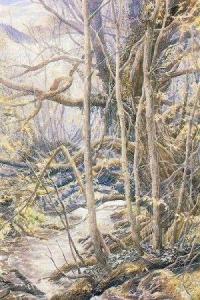 Forest
on the east side of the Brandywine River
bordering Buckland. The trees of the
Old Forest had a strange reputation. They appeared to be able to communicate
with each other. The trees were said to dislike people and would sometimes
drop branches of stick out roots unexpectedly. It was rumored that the
trees would even surround intruders on occasion. Something in the forest
made paths, but they would shift.
Forest
on the east side of the Brandywine River
bordering Buckland. The trees of the
Old Forest had a strange reputation. They appeared to be able to communicate
with each other. The trees were said to dislike people and would sometimes
drop branches of stick out roots unexpectedly. It was rumored that the
trees would even surround intruders on occasion. Something in the forest
made paths, but they would shift.
The Hobbits of Buckland had erected a tall, thick hedge called the High Hay which ran over 20 miles along the outskirts of the Old Forest from the Brandywine Bridge to the mouth of the River Withywindle at Haysend. But the trees of the Old Forest attacked the High Hay and the Hobbits retaliated by cutting a swath through the trees at the edge of the forest and burning them. A bare patch still remained and was known as the Bonfire Glade.
The Brandybucks sometimes visited the Old Forest and had a secret gate in the Hedge. On September 26, 3018 of the Third Age, Merry Brandybuck led his companions through the gate. Though the trees crowded around them, they made it to the Bonfire Glade and found a straight path that led them to a bare hill where they rested. But when they continued on they discovered that instead of heading north toward the Great East Road as they intended, they were being forced south and east into the valley of the River Withywindle - which was said to be the center of all the queerness in the Old Forest.
Soon the Hobbits were at the River Withywindle itself. Drowsiness overcame the Hobbits and they felt compelled to stop and rest. Merry and Pippin sat against a willow tree, while Frodo sat on one of its roots and bathed his feet in the water. Only Sam remained awake. Suddenly the tree pushed Frodo into the river and held him under with its roots. Sam pulled him out and they discovered that Merry and Pippin had been trapped inside the willow tree. Frodo and Sam threatened the tree with fire but were forced to stop when the tree started squeezing Merry. Not knowing what else to do, Frodo ran down the path and called for help.
His call was answered by Tom Bombadil, who rescued Merry and Pippin by singing to Old Man Willow and telling him to release the Hobbits. From Tom, they learned that the Old Forest had once been part of a vast woodland and that the ancient trees that remained resented the peoples who walked the earth. Old Man Willow was the most dangerous of these, and he had spread his dominion over all of the Old Forest.
Later, in Fangorn Forest, Treebeard told Merry and Pippin that the Old Forest was once part of the great wood that stretched from Fangorn to the Blue Mountains in the northwest. Treebeard was not surprised to learn that darkness still lingered in the trees of the Old Forest, because he knew of similar bad patches in Fangorn.
Sources:
The Fellowship
of the Ring: "A Conspiracy Unmasked," p. 117-18; "The Old Forest,"
passim; "In the House of Tom Bombadil," p. 141
The Two
Towers: "Treebeard," p. 71-72
Taur-im-DuinathForest in Beleriand. Taur-im-Duinath was located in southern Beleriand between the Gelion and the Sirion. The Gelion flowed along the eastern border of Taur-im-Duinath and then curved around the southern end of the forest to the Sea. The Sirion was west of the forest, forming a large delta called the Mouths of Sirion as it flowed into the Bay of Balar. A range of hills known as Andram, or the Long Wall, was north of Taur-im-Duinath.Taur-im-Duinath was a large, wild, tangled woodland. The forest was uninhabited except for a few Dark Elves who wandered there. Morgoth's forces did not reach Taur-im-Duinath when they invaded Beleriand during the Battle of Sudden Flame. Taur-im-Duinath was destroyed along with most of the rest of Beleriand in the War of Wrath at the end of the First Age. Names &
Etymology:
Sources:
|
Map
of Taur-im-Duinath
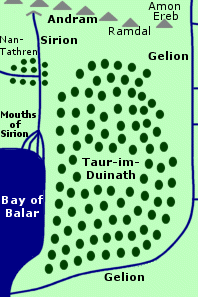 |
Trollshaws |
The
Trollshaws by Robert Goldsmith
|
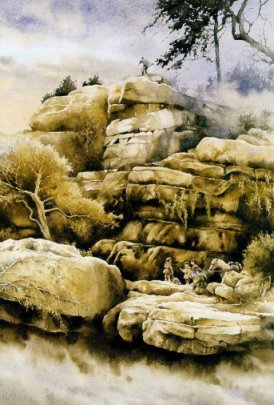 Woods
frequented by Trolls in Eriador.
The Trollshaws were located between the River
Hoarwell and the River Bruinen north
of the Great East Road. The Last
Bridge spanned the Hoarwell west of the Trollshaws, and Rivendell
was across the Bruinen east of the woods. North of the Trollshaws were
the Ettenmoors, or Troll-fells - a
high, barren land inhabited by Trolls.
Woods
frequented by Trolls in Eriador.
The Trollshaws were located between the River
Hoarwell and the River Bruinen north
of the Great East Road. The Last
Bridge spanned the Hoarwell west of the Trollshaws, and Rivendell
was across the Bruinen east of the woods. North of the Trollshaws were
the Ettenmoors, or Troll-fells - a
high, barren land inhabited by Trolls.
The Trollshaws stretched over 50 miles from east to west. Many of the trees were pines, though there were some beech trees as well. The land where the woods grew was hilly. The hills became higher deep in the forest, and narrow ravines wound among them.
There was at least one path in the forest made by Trolls, but for the most part there was no easy way through the Trollshaws. The ground was littered with stones and fallen trees. The ravines ran in different directions and some had dead ends and steep cliffs on either side. In some of the hills there were shallow caves, and on top of some of the hills there were castles and towers that had been built by the Men of Rhudaur.
Rhudaur was one of the three Kingdoms of the Dunedain that resulted from the division of the North-kingdom in 861 of the Third Age. Rhudaur was the easternmost Kingdom and it included the Trollshaws. The Dunedain of Rhudaur diminished and control was seized by a lord of the Hill-men who was secretly allied with the Witch-king of Angmar. In 1409, the remaining Dunedain were slain or driven out. Rhudaur fell completely under the control of the Witch-king, and the Men who lived there were evil.
When the Witch-king was defeated in 1975, the Men of Rhudaur were completely destroyed. The area, including the Trollshaws, became largely uninhabited. The fortifications in the forest fell into ruin. Trolls came down from the Ettenmoors and roamed the forest, preying on travellers on the Great East Road. Among these were Tom, Bert, and William.
In late May of 2941, Bilbo Baggins came upon Tom, Bert, and William in the Trollshaws. Bilbo tried to pick William's pocket but he was caught, as were Thorin and the other Dwarves who came looking for the Hobbit. Gandalf tricked the Trolls into arguing until dawn, and when the sun came up Tom, Bert, and William were turned into stone.
The Trolls' hoard was discovered in a cave blocked with a stone door that was unlocked with a key found by Bilbo. Gandalf acquired Glamdring from the hoard and Thorin took Orcrist, while Bilbo found a small sword that he later named Sting. They buried the Trolls' gold near the road under a marked stone, and Bilbo and Gandalf retrieved it on the way home from their adventure in 2942.
Many years later, on October 13, 3018, Aragorn led Frodo Baggins and his companions into the Trollshaws in order to escape the Nazgul who had attacked them on Weathertop. Frodo was wounded and had to ride Bill the Pony, making the passage through the Trollshaws even more difficult. They ended up going far north out of their way.
On October 18, they came upon the stone figures of Tom, Bert, and William, which Merry and Pippin mistook for real Trolls. Sam recited a poem about Trolls which lightened everyone's spirits. That afternoon, they finally came back to the Great East Road after six days in the Trollshaws.
Names &
Etymology:
The name Trollshaws means
"Troll woods"; shaw is an old word meaning "woods."
Sources:
The Hobbit:
"Roast Mutton," p. 41-54; "A Short Rest," p. 62; "The Last Stage," p. 312
The Fellowship
of the Ring: "Flight to the Ford," p. 212-221
Appendix
A of The Lord of the Rings: "The North-kingdom and the Dunedain," p.
320-21
Woody End |
The
Woody End in the
New Line film
|
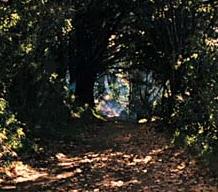 Woods
in the Eastfarthing of the Shire. The Woody End
was located at the eastern end of the Green
Hill Country. The Stockbrook flowed
northeast through the Woody End to the Brandywine
River. The Stock Road from Tuckborough
to Stock passed through the northern edge
of the Woody End, and a lane branched off the road to Woodhall,
a village in the northeast corner of the Woody End. Pincup
was a village at the far western end of the Woody End.
Woods
in the Eastfarthing of the Shire. The Woody End
was located at the eastern end of the Green
Hill Country. The Stockbrook flowed
northeast through the Woody End to the Brandywine
River. The Stock Road from Tuckborough
to Stock passed through the northern edge
of the Woody End, and a lane branched off the road to Woodhall,
a village in the northeast corner of the Woody End. Pincup
was a village at the far western end of the Woody End.
Frodo, Sam and Pippin followed the Stock Road into the Woody End on September 24, 3018 of the Third Age, on their way to Crickhollow. Near sunset, they heard a horse on the road and Frodo, feeling suddenly uneasy, told his companions to hide among the trees. A Black Rider appeared and seemed to be sniffing, looking for something. The Black Rider was Khamul, one of the Nazgul. Khamul was hesitant in the daylight and he left without discovering the Hobbits.
The Hobbits continued on their way, turning along the lane that branched off the Stock Road toward Woodhall. The Nazgul appeared again, but this time the singing of a passing company of Elves caused him to flee. Gildor Inglorion, leader of the Elves, invited the Hobbits to camp with them on a greensward in the woods near Woodhall.
The next morning, the Elves had departed, and Frodo decided to cut across country to the Bucklebury Ferry rather than returning to the road. Pippin warned him that "Short cuts make long delays," (FotR, p. 97) but Frodo prevailed. They climbed down a steep bank just in time to avoid the Nazgul again. Pippin realized that they were at the Stockbrook and that they needed to cross it and bear right, but they ended up going too far south and were in the woods longer than they intended to be. They emerged from the Woody End at Farmer Maggot's fields in the Marish.
After the War of the Ring, Frodo met Gandalf, Bilbo, Elrondand Galadriel in the Woody End on September 22, 3021. The Last Riding of the Keepers of the Rings traveled together to the Grey Havens and passed over the Sea.
Sources:
The Fellowship
of the Ring: Map of "A Part of the Shire"; "Three Is Company," p. 82-94;
"A Short Cut to Mushrooms," p. 97-100
The Return
of the King: "The Grey Havens," p. 307-9
All entries are Copyright © by the Thain from former tuckborough.net. Please contact me if you are Thain or know anything about how to contact the original author.
2003-2011, The Thain's Book - thainsbook.minastirith.cz-
e-mail:
thain at tuckborough.net